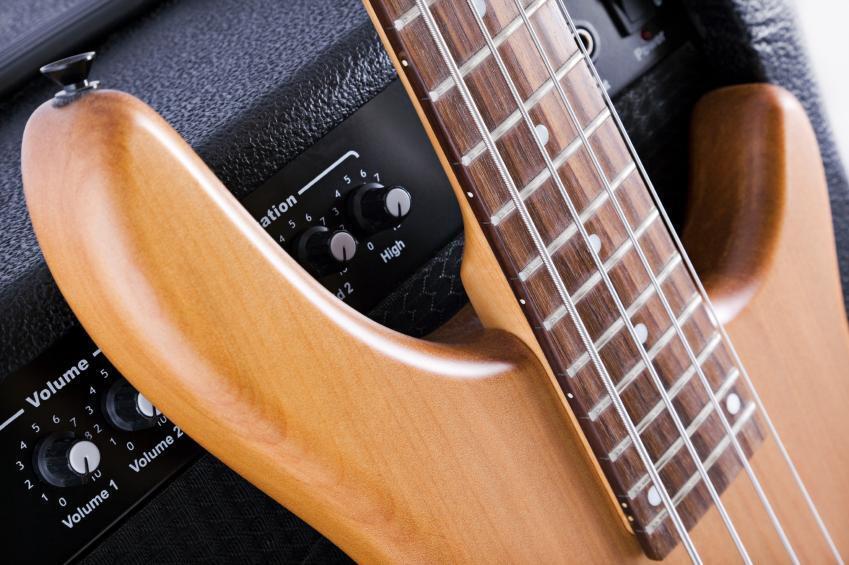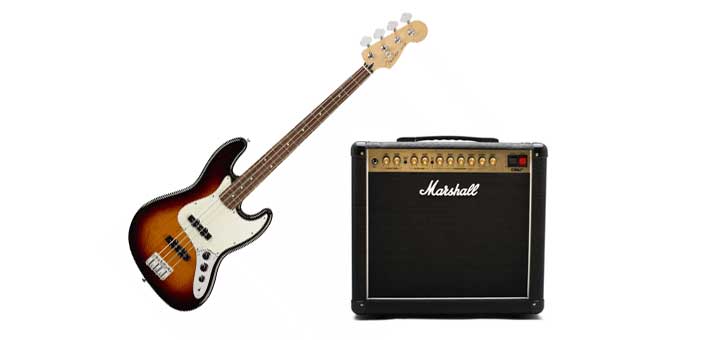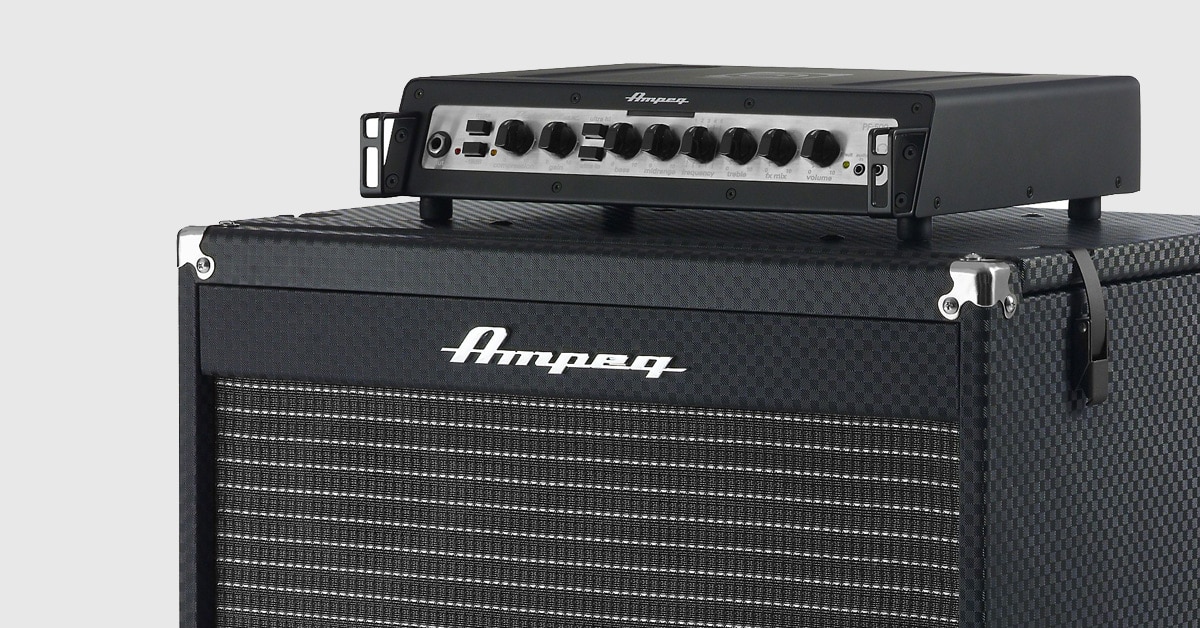Choosing the right amp for bass guitar depends on your specific needs and budget. A good practice amp starts around 15 to 25 watts, while performance amps can be 100 watts and above.
Selecting an appropriate amp for your bass guitar is a crucial decision that can significantly affect your sound and playing experience. A smaller, low-wattage amplifier is perfect for practice and small venues, offering portability and ease of use. On the other hand, for live performances and larger spaces, a high-wattage amp delivers the necessary power and volume to cut through the mix and provide a full, rich tone.
Key features to consider include tone-shaping controls, built-in effects, and connectivity options for added versatility. Brands like Fender, Ampeg, and Markbass are popular among bassists, each offering a range of models to suit various styles and levels of play. Make sure to test different amps with your bass guitar to find the one that best complements your sound and style.

Credit: www.sweetwater.com
Introduction To Bass Guitar Amplification
Plucking the strings of a bass guitar without amplification is like whispering in a roaring stadium – hardly anyone notices. The moment an amplifier enters the scene, the bass trots out upfront with assertive soundwaves that empower every note. Whether you’re a heart-beating beginner or a gigging guru, understanding the impact of amplification on your bass performance is crucial for conjuring those signature low-end rumbles that define genres, moods, and songs.
Understanding The Role Of The Amplifier In Bass Guitar Performance
Bass amplifiers are not just about volume; they shape the tone and quality of sound. They work to faithfully reproduce low frequencies, which are critical for a bass guitar’s sonic presence. Here’s why quality amplification is a non-negotiable facet:
- Clarity: Crystal-clear reproduction allows each note to stand out, even in complex mix situations.
- Punch: Good amplifiers pack a punch that lends the bass its dynamic and percussive character.
- Versatility: Modern amps offer a range of features allowing bassists to sculpt their preferred sounds, adapting to various genres and playing techniques.
- Durability: Built to withstand low-frequency vibrations, bass amps ensure consistent performance from studio to stage.
The Evolution Of Bass Amplification Technology
From humble beginnings to cutting-edge digital wonders, bass amplification technology has undergone a profound transformation. Analog stalwarts paved the way, with vacuum tubes glowing warmly as they amplified the earliest electric bass guitars. Nowadays, lightweight class-D amps and sophisticated modeling technology promise endless tonal possibilities and convenience for players of all levels.
| Year | Technological Advancements |
|---|---|
| 1950s | Tube amplifiers dominate, offering warm tones. |
| 1970s | Introduction of Solid-state amplifiers – reliable and maintenance-free. |
| 1990s | Bass amp modeling emerges, emulating classic sounds through digital technology. |
| 2000s & Beyond | Class-D amplifiers bring power and portability, with digital modeling refining user experience. |
The quest for sonic perfection and performance reliability continues to drive manufacturers in their design and innovation, much to the benefit of bassists aiming for that ideal sound. With such a broad array of bass amplifiers on the market, arming yourself with information on how they shape your sound is essential. Dive into the depths of bass amplification with us, and let’s strike the right chord together.

Credit: guitargearfinder.com
Types Of Bass Amplifiers
Finding the perfect amp for your bass guitar can unlock new realms of sound. To achieve the ideal tone, understanding the various types of bass amplifiers is fundamental. From the warmth of tubes to the durability of solid-state, the world of bass amplification is diverse and sophisticated, with options to fit any style and budget. Let’s dive into the different amplifiers and what sets them apart.
Difference Between Tube, Solid-state, And Hybrid Amps
The core of bass amplification splits into three main categories: tube, solid-state, and hybrid amps. Tube amps, known for their rich harmonics and organic sound, utilize vacuum tubes to amplify the signal, offering a classic tone that’s preferred by many professional bassists. In contrast, solid-state amps rely on transistors for a reliable, consistent sound that’s often more affordable and rugged than their tube counterparts. Hybrid amps combine both technologies, offering the best of both worlds with the warm tone of tubes in the preamp stage and the reliability and power of solid-state in the output stage.
Combo Amps Vs. Amp Heads And Cabinets
The debate between combo amps and amp heads with separate cabinets can be pivotal in a bassist’s gear selection. Combo amps integrate the amplifier and speaker in one convenient unit, making them ideal for practice sessions and small venues. They’re known for their ease of transport and simplified setup. Contrastingly, amp heads and cabinets offer a customizable approach. The amp head contains all the amplification circuitry, while the cabinet houses the speakers. This configuration allows for greater flexibility in sound and power options, preferred for larger venues and touring.
Modeling Amplifiers And Effects Integration
In the realm of modern technology, modeling amplifiers stand out as a versatile choice for bass players. These amps use digital processors to simulate the sounds of traditional amplifiers, giving players a plethora of tones at their fingertips. With built-in effects and the ability to save presets, modeling amps provide a compact and convenient way to experiment with various sounds. The integration of effects with amplifier modeling enables seamless performance and creative exploration, making these amplifiers a compelling choice for bassists who love to push sonic boundaries.
Factors To Consider When Choosing A Bass Amp
When embarking on the journey to find the perfect bass amp, several crucial factors come into play. It’s not just about the aesthetics or the brand; it’s about understanding the core attributes that will enhance your sound and performance. As a bassist, recognizing these elements is essential to tailor your rig for the ultimate musical expression. Below, we discuss these factors in detail.
Determining The Right Wattage For Your Needs
Wattage is a key determinant of an amp’s power and volume. Selecting the right wattage is contingent on your playing environment:
- Practice sessions: For personal use, amps ranging from 20 to 100 watts are ample.
- Small venues: Gigs in cafes or churches often necessitate between 100 to 200 watts.
- Large venues: Concerts or open stages may require 200 watts or more for a full, rich sound that fills the space.
Considering Portability Vs. Power In Gig Settings
Finding the right balance between portability and power is pivotal for gigging musicians:
- Combo amps offer convenience for transportation but may lack the raw power of separate heads and cabinets.
- Consider a setup with wheels or a lightweight design if frequent travel is expected.
The Impact Of Speaker Size And Configuration
Speaker characteristics directly influence tone and volume:
- Larger speakers (15-inch) produce deeper tones but may be less portable.
- Smaller speakers (10-inch) offer punchier sounds and are typically housed in more manageable cabinets.
- Cabinet design and the number of speakers also affect sound dispersion and frequency response.
Impedance Matching And Connectivity Options
Ensuring your amp and cabinet impedance ratings align is vital for performance:
| Impedance (Ohms) | Power Handling |
|---|---|
| 4Ω | Maximum power from the amp |
| 8Ω | Reduced power, more options for cabinet combinations |
Connectivity dictates versatility. Look for features like:
- Headphone jacks for silent practice
- DI outputs for direct recording or PA system connection
- Effect loops and footswitch inputs for greater control
Budget And Brand Considerations
Budget can significantly shape your amp choice. Align your investment with your needs, keeping in mind that:
- Higher-end brands may offer superior tone and build quality.
- Mid-range models provide a balanced mix of quality and affordability.
- Cost-effective options are available for beginners or those on a tight budget.
Popular Bass Amp Models And Their Features
As part of the rhythmic backbone of a band, bass players understand the importance of having a robust and reliable amp to deliver that crucial low-end punch. With a plethora of models on the market, each offering a unique set of features, it can be a daunting task to choose the right one. In this section, we delve into some of the most revered bass amp models, uncovering what makes them the go-to choice for bassists across genres and skill levels.
Reviewing Industry Standards: Fender, Ampeg, And Markbass
Fender, Ampeg, and Markbass stand tall as the titans of the bass amp world, each brand boasting an impressive legacy backed by groundbreaking innovation. Let’s dive into what puts these brands at the forefront:
- Fender: The legendary Bassman series, often praised for its rich, full tone and versatility, is a classic choice. Fender amps typically feature simple controls, durable construction, and a purity of sound that’s uncolored and clear.
- Ampeg: Known for the iconic SVT series, Ampeg amps are synonymous with warm tube-driven sound and massive power. With their signature Ultra Hi/Lo boosts and multiple EQ options, they’re a favorite among professional bassists.
- Markbass: Offering lightweight designs without compromising on tone, Markbass is popular for their high-fidelity sound and innovative features such as the Variable Pre-shape Filter (VPF) that enhances the richness of the bass.
Emerging Brands And Innovative Designs
New players are constantly entering the bass amp market, bringing with them a wave of innovation and cutting-edge technology. Brands such as Darkglass Electronics and Aguilar are quickly becoming favorites among bassists seeking modern features and unique tonal capabilities. These include programmable EQ settings, advanced D-Class power amplification, and the integration of digital modeling technology.
Pros And Cons Of Popular Models
| Model | Pros | Cons |
|---|---|---|
| Fender Bassman |
|
|
| Ampeg SVT |
|
|
| Markbass Big Bang |
|
|
Practical Tips For Bass Amp Usage
Mastering the art of the bass involves not just nailing the technique on the strings but also understanding how to effectively use your bass amp. In this section, we’ll delve into practical tips for leveraging your bass amp to its fullest potential. From tweaking EQ and effects to maintain the longevity of your amp, to optimizing its output in various environments, these insights will help you create a richer and more professional sound whether you’re laying down tracks in the studio or pumping up the crowd live.
Dialing In Your Tone: Eq And Effects Settings
Understanding your amp’s equalizer (EQ) is essential for shaping the perfect bass tone. Here’s how:
- Start Neutral: Begin with all EQ knobs at the midpoint before making adjustments.
- Find Your Frequency: Each genre has a sweet spot. Experiment with the low, mid, and high frequencies to find what complements your style of play.
- Effects: Use effects sparingly. An overdrive or a compressor can add depth, but too much can muddy your sound.
Maintaining And Caring For Your Amp
To ensure your amp stands the test of time:
- Regular Cleaning: Dust and debris can impair functionality. A soft cloth does wonders.
- Proper Storage: Keep it in a cool, dry place and use a protective cover when not in use.
- Check Connections: Loose cables can cause sound issues. Secure all input and output connections.
Strategies For Mic’ing And Di Output In Live And Studio Settings
Capturing crisp bass sound is key in live and studio environments:
- Mic Placement: Position the microphone close to the speaker but slightly off-center for a balanced tone.
- DI Units: Direct Injection (DI) boxes can streamline the signal directly to a console, retaining clarity, especially in a mix.
- Combination Approach: Blend mic and DI outputs to achieve a rich, full-bodied sound with both texture and definition.

Credit: www.musiciansfriend.com
Future Of Bass Amps And Advancements
The realm of bass amplification is an evolutionary field where the blend of technology and creativity pushes the boundaries to new horizons. While the fundamental quest for that perfect low-end rumble remains, the means to achieve it have seen significant advancements. The future of bass amps is being shaped today with innovations that promise to enhance the sonic experience for bassists around the globe. Let’s explore some of these technological strides dawning upon us in the world of bass amplification.
Developments In Digital Amplification And Software
The era of digitalization has made a profound impact on bass amplifiers. The development of digital amplification has given rise to a new palette of sounds, allowing for intricate modeling of vintage amps and the creation of previously unimaginable tones. This advancement doesn’t only offer exceptional sound quality but also provides versatility and convenience – a single unit can now emulate the characteristics of multiple amps.
Alongside hardware, software applications have opened doors to a virtual world of amplification. These programs offer:
- Vast libraries of amp models and effects
- User-friendly interfaces for tone manipulation
- Integrated recording and playback tools
- Community-sharing platforms for presets and sound design
Product developers have moved beyond traditional amp design, focusing on software that allows for real-time adjustments to tonality and texture, catering to both studio needs and live performances.
The Increasing Popularity Of Lightweight And Class D Amps
Gone are the days when gigging bassists had to deal with the backbreaking heft of heavy amps. The rise of lightweight and Class D amplifiers has revolutionized portability without compromising on power or sound. Some key features making Class D amps the go-to choice for many include:
| Feature | Advantage |
|---|---|
| Lightweight construction | Easy transportation and minimized strain during setup |
| Energy Efficiency | Less heat production and reduced power consumption |
| Consistent performance | Reliability across various environments and volumes |
These advancements have led to a surge in popularity for these types of amplifiers, especially for bassists regularly performing across different venues.
Anticipated Trends In Bass Amplification
As we look toward the future, certain trends are projected to define the next wave of bass amplification. Musicians can expect to see continued refinements in:
- Hybrid Technology: Combining the warmth of tube amplifiers with the precision of solid-state design.
- Connectivity: Amps with built-in Wi-Fi and Bluetooth capabilities for seamless integration with devices and apps.
- Modularity: Users will be able to customize and expand their rigs with modular components, adapting to their evolving needs.
In addition, the push for sustainability and eco-friendly materials will likely influence amp construction, catering to the green-conscious musician without losing sight of performance or durability.
The future shines bright for bass amplification as players and engineers alike continue to chase the perfect sound, with trailblazing advancements waiting just around the corner. It’s an electrifying time for bassists looking to plug into the next generation of sound.
What Kind of Amp is Best for Bass Guitars?
When selecting an amplifier for your instrument, consider the nuances of sound and power. The right amp enhances tone and clarity, ensuring optimal performance. For those curious about the intersection of gear, bass guitars and amp compatibility explored reveals essential insights, helping players achieve their desired sound effortlessly.
Frequently Asked Questions On What Amp For Bass Guitar
What Amp Do You Need For A Bass Guitar?
For a bass guitar, you typically need an amplifier specifically designed for bass, often ranging from 15 watts for practice to 500 watts for live performances. Select an amp that matches your venue size and sound requirements.
Does A Bass Guitar Need A Special Amp?
Yes, bass guitars typically require a bass amplifier to accurately reproduce low-frequency sounds. Standard guitar amps may not effectively deliver the bass tones.
How Do I Choose A Bass Amp?
To choose a bass amp, consider your venue size, opting for higher wattage for larger spaces. Assess sound clarity and tonal options, ensuring it matches your music style. Prioritize portability if gigging frequently, and check for compatible connection options for your instruments and effects.
Test durability for long-term use.
What Is The Best Amp For Bass?
The best bass amp varies by need, but the Fender Rumble 200 is widely acclaimed for its power and tone clarity. It balances performance with portability, making it a top choice for both practice and performance.
Conclusion
Selecting the right amplifier for your bass guitar is pivotal to achieving the sound that resonates with your musical style. From practice sessions to live gigs, the proper amp can elevate your performance. Remember, the key lies in understanding your needs and the features that compliment them.
With the right amp, the power of your bass will truly shine through.
